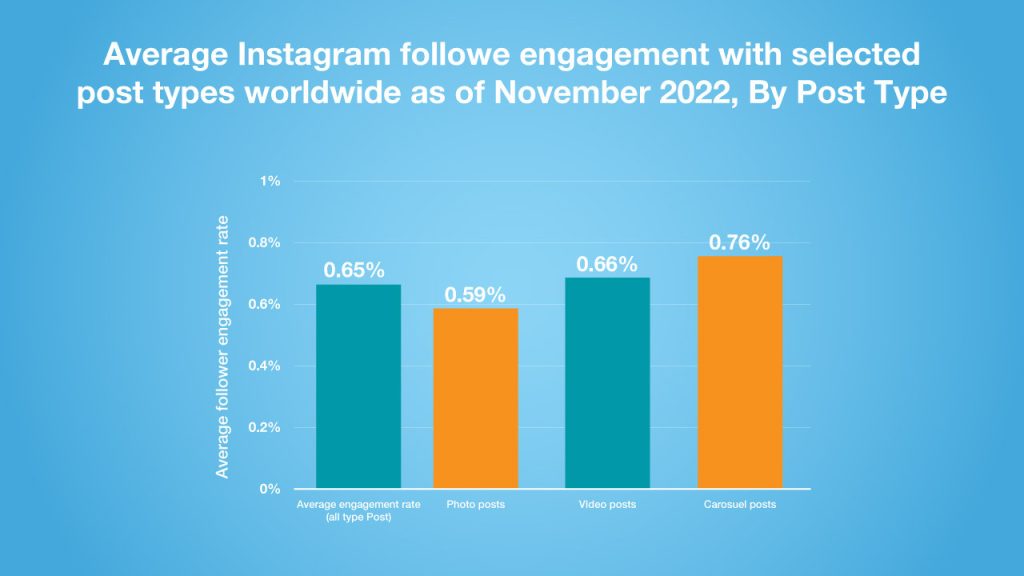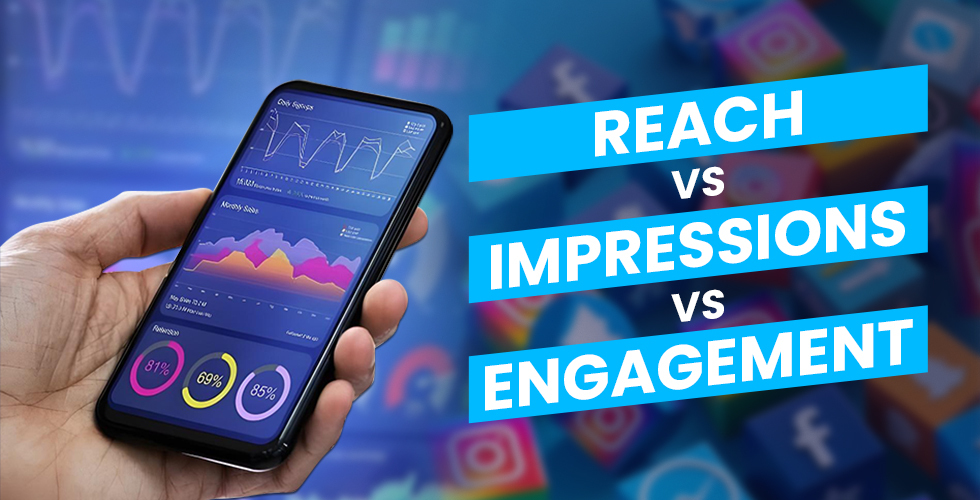What is the difference between reach, impressions, and engagement? Which one should you focus on, and how do you track them across different platforms? Let’s decode all these answers together.
Social media marketers have a common goal: to ensure their content reaches as many people as possible. We measure this success using metrics like reach, impressions, and engagement.
All these metrics track the visibility of our content and help us understand our social media growth, but they do so in slightly different ways.
Reach vs Impressions vs Engagement: What’s The Difference?
Impressions, reach, and engagement are fundamental terms in marketing analytics, yet they possess distinct characteristics.
- Reach is the number of unique people who see your content, doesn’t matter how many times they see it.
- Impressions are the number of times your content is displayed on someone’s screen, whether they click or not.
- Engagement is the number of interactions your content receives from users, such as likes, comments, shares, saves, etc.
Let’s simplify their definitions, and figure out how each metric works and why it matters.
Reach
Reach is a measure of how many people see your content on social media. It is the total number of unique users who have seen your content, regardless of how many times they have seen it. Many social media platforms like Facebook allow you to track the reach of both your overall content and individual posts.
Imagine you have an advertisement that gets displayed on a screen 1,000 times, reaching a total of 500 unique users. In this scenario, your reach would be 500 users. Among these users, some might have encountered your ad once, while others may have seen it multiple times during the 1,000 impressions.
Reach is important because it tells you how far your content is spreading and how many potential customers you are reaching. However, reach alone does not guarantee any actual impact or conversion. You also need to consider other factors such as relevance, frequency, and quality of your content.
Impression
Impressions on social media refer to the total count of times your content has been viewed, which includes both unique and repeated views by individual users. Let’s consider a Facebook Ad that has been displayed 1,000 times on screens. In this case, it has accumulated a total of 1,000 impressions.
So, to calculate impressions, platforms track the overall number of times your content is displayed, whether it appears in users’ feeds, search results, or other areas.
If you observe significantly more impressions than reach, it suggests that people are repeatedly viewing your post. This is a positive indicator, demonstrating that your target audience finds your content memorable and engaging.
Impressions are useful because they show you the potential exposure and visibility of your content. Impressions do not necessarily mean that people are paying attention to your content or taking any action. You also need to consider other factors such as context, timing, and format of your content.
Engagement
Engagement refers to the actions users take with the content, which can include various interactions such as clicking through to a website from an advertisement, sharing a website article on social media, commenting on a blog, and many more.
Engagement is the only metric among these three that demonstrates active user involvement with the content. With impressions, it is uncertain whether the person viewing the screen is actually noticing your ad amidst other distractions.
Similarly, reach alone does not guarantee any actual impact, even if a user is repeatedly exposed to the same ad. Engagement provides insights into how people are responding to your content.
It shows you the level of interest and loyalty that your audience has with your brand. It also helps you measure the effectiveness and ROI of your content marketing efforts.
How Do They Differ Across Social Media?
The metrics of reach, impressions, and engagement provide insights into the visibility of your social media content. While they are closely related, there are subtle yet significant distinctions between them, and their definitions may vary slightly across different platforms.
Facebook Reach vs. Impressions vs. Engagement
Facebook measures the reach and impressions of your content in three different ways: organic, paid, and viral.
- Organic Reach: It’s the number of unique people who saw your content for free in the News Feed. This is the most important type of reach, as it’s the most likely to lead to engagement.
- Paid Reach: It’s the number of unique people who saw your content because they saw a paid ad. This type of reach can be a good way to reach a wider audience, but it’s important to make sure that your ads are targeted well.
- Viral Reach: It’s the number of unique people who saw your content because a friend shared it. This type of reach is the most unpredictable, but it can be very powerful if your content goes viral.
Engagement is a measure of how people interact with your content. This includes things like likes, comments, shares, and clicks. Engagement is important because it shows that people are interested in your content and that they’re taking action.
Images are powerful tools for boosting Facebook engagement. According to BuzzSumo, posts with pictures get more than double the interactions of those without. Similarly, articles that include an image every 75 to 100 words get twice as many shares as articles with fewer images.
Instagram Reach vs. Impressions vs. Engagement
Instagram defines Accounts Reached as the metric that represents the number of unique accounts that have viewed your content on their screen at least once. This provides insights into the reach of your content and how many individual accounts it has reached.
On the other hand, Instagram impressions refer to the total number of times your content has been seen, including both initial views and subsequent views from the same user. Impressions provide a measure of the overall visibility and exposure of your content.
Instagram provides additional insights into the engagement of your content through the metric of “Accounts Engaged.” This metric measures the number of unique accounts that have interacted with your content, such as liking a post, commenting, saving it, or sharing it with others.
A survey by Statista showed that Instagram was the most engaging social network for brands in 2022, with an average engagement rate of 0.65%. Videos engaged users more than photos, with 0.66% and 0.59% respectively. However, carousel posts outperformed both, reaching 0.76% engagement.

Twitter Reach vs. Impressions vs. Engagement
Twitter does not directly measure reach within its native app, but it does provide insights into impressions. Twitter provides you with the total impressions of each tweet, representing the number of times it appears on a user’s feed or in search results. This metric gives you insights into the overall visibility and exposure of your tweets to Twitter users.
To access detailed engagement metrics, click on “View Tweet activity.” This will provide you with a breakdown of specific engagement actions, including detailed expands link clicks, profile clicks, and more.
Fact: Video tweets boost engagement by 10x compared to non-video tweets, according to Twitter Business!
Which One Comes on Top?
The choice between reach, impressions, and engagement depends on your specific goals and priorities. If your primary focus is expanding your audience as much as possible, reach may be the preferred metric.
On the other hand, if you aim to make a lasting impression and enhance content memorability, higher impressions could be more desirable. And Engagement, on the other hand, helps you track and measure the level of interaction and involvement that your audience has with your content.
By tracking engagement, you can effectively measure the cost associated with each user action, allowing you to evaluate the ROI of your advertising efforts accurately.




